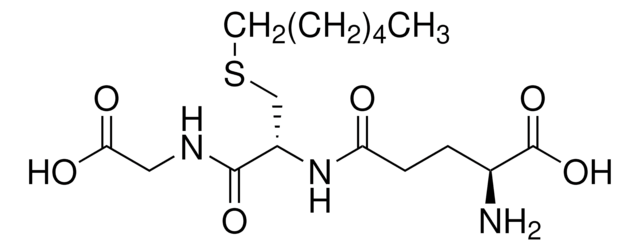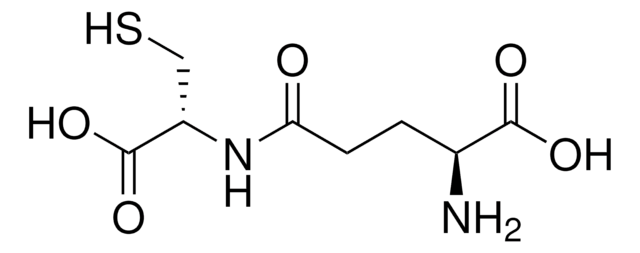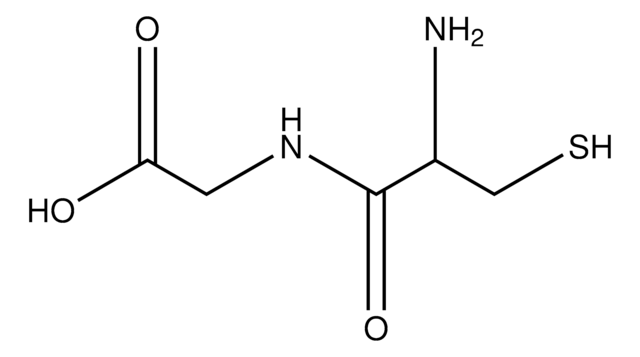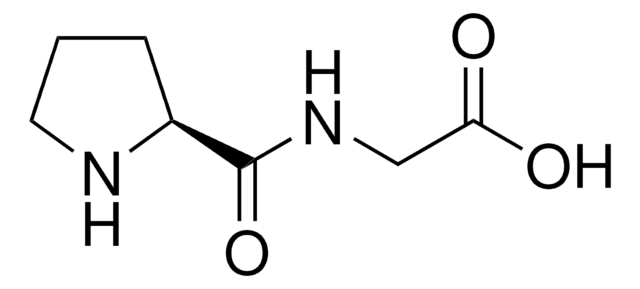Wszystkie zdjęcia(3)
Kluczowe dokumenty
M4139
S-Methylglutathione
>98% (TLC), suitable for cell culture
Synonim(y):
L-γ-glutamylo-S-metylo-L-cysteinyloglicyna
Zaloguj sięWyświetlanie cen organizacyjnych i kontraktowych
About This Item
Wzór empiryczny (zapis Hilla):
C11H19N3O6S
Numer CAS:
Masa cząsteczkowa:
321.35
Numer MDL:
Kod UNSPSC:
12352209
Identyfikator substancji w PubChem:
NACRES:
NA.26
Polecane produkty
Nazwa produktu
S-Methylglutathione,
Próba
>98% (TLC)
Formularz
powder
metody
cell culture | mammalian: suitable
kolor
white
temp. przechowywania
2-8°C
ciąg SMILES
CSCC(NC(=O)CCC(N)C(O)=O)C(=O)NCC(O)=O
InChI
1S/C11H19N3O6S/c1-21-5-7(10(18)13-4-9(16)17)14-8(15)3-2-6(12)11(19)20/h6-7H,2-5,12H2,1H3,(H,13,18)(H,14,15)(H,16,17)(H,19,20)
Klucz InChI
QTQDDTSVRVWHMO-UHFFFAOYSA-N
Powiązane kategorie
Działania biochem./fizjol.
S-metyloglutation jest peptydem zawierającym metioninę i inhibitorem glioksylazy.
Substraty
Przydatny jako inhibitor glioksylazy.
Ta strona może zawierać tekst przetłumaczony maszynowo.
Kod klasy składowania
11 - Combustible Solids
Klasa zagrożenia wodnego (WGK)
WGK 3
Temperatura zapłonu (°F)
Not applicable
Temperatura zapłonu (°C)
Not applicable
Środki ochrony indywidualnej
Eyeshields, Gloves, type N95 (US)
Wybierz jedną z najnowszych wersji:
Masz już ten produkt?
Dokumenty związane z niedawno zakupionymi produktami zostały zamieszczone w Bibliotece dokumentów.
Klienci oglądali również te produkty
M F Phillips et al.
The Biochemical journal, 294 ( Pt 1), 57-62 (1993-08-15)
Mouse liver glutathione S-transferase YfYf (Pi class) reacts with [14C]ethacrynic acid to form a covalent adduct with a stoichiometry of 1 mol per mol of subunit. Proteolytic digestion of the enzyme-[14C]ethacrynic acid adduct with V8 protease produced an 11 kDa
M Müller et al.
Archives of toxicology, 74(12), 760-767 (2001-04-18)
Glutathione-S-transferase T1 (GSTT1-1) is a major isoenzyme for the biotransformation of halomethanes. The enzyme activity is located, among other places, in human liver and erythrocytes and is subject to a genetic polymorphism. Metabolism of the halomethanes via GSTT1-1 yields S-methylglutathione
Y Manabe et al.
Chemical senses, 25(2), 173-180 (2000-04-26)
Tentacle ball formation (TBF) in Hydra elicited by S-methylglutathione (GSM) was modulated by a number of biologically active peptides. Hydra fed on Artemia, which had been hatched in a common salt solution supplemented with LiCl and ZnCl(2), easily induced TBF
K Hanai
Comparative biochemistry and physiology. Part A, Molecular & integrative physiology, 119(1), 333-339 (2001-03-20)
Within minutes, brief treatment with trypsin potentiated tentacle ball formation in Hydra japonica, a new behavioral response to reduced glutathione. With the potentiation of this behavioral response, new glutathione-binding proteins were immediately detected after the trypsin treatment of live Hydra
O K Vatamaniuk et al.
The Journal of biological chemistry, 275(40), 31451-31459 (2000-05-16)
The dependence of phytochelatin synthase (gamma-glutamylcysteine dipeptidyltranspeptidase (PCS), EC ) on heavy metals for activity has invariably been interpreted in terms of direct metal binding to the enzyme. Here we show, through analyses of immunopurified, recombinant PCS1 from Arabidopsis thaliana
Nasz zespół naukowców ma doświadczenie we wszystkich obszarach badań, w tym w naukach przyrodniczych, materiałoznawstwie, syntezie chemicznej, chromatografii, analityce i wielu innych dziedzinach.
Skontaktuj się z zespołem ds. pomocy technicznej






